Efflorescence is a white chalk-like substance that is commonly found on internal and external brickwork, mortar and also plastered and rendered surfaces. Although it isn’t itself dangerous it can be a sign of other more worrying issues.
In this guide you will learn exactly what efflorescence is, what can cause it and how you can deal with it permanently.
What is efflorescence?
Efflorescence is a type of white chalky deposit found on brick, masonry, concrete and plastered surfaces. It is formed when natural salts and minerals in these materials dissolve in water present in the material, the water travels to the surface, evaporates and the mineral deposits are left as white chalky stains.
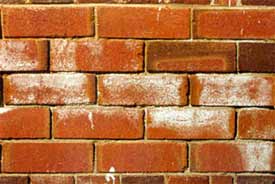
Damaged Brickwork caused by efflorescence on brick
Sometimes Efflorescence is confused with spalling – this is damaged brickwork where the surface of the bricks starts to crumble because of Freeze/Thaw action, after it has become saturated in the winter months.
However this is a different problem to efflorescence (also known as "salting"). You can read more about spalling in our project on freeze/thaw damage.
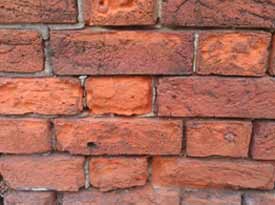
Damaged Brickwork caused by weathering
A definition for Efflorescence is a staining of brickwork, masonry and concrete, caused by salts being washed out of construction materials, and being deposited on the surface of building materials by the evaporation process of water.
Efflorescence itself is not causing damage to the wall but it will damage any paintwork or wallpaper that you put over interior walls affected by efflorescence.
Salting on bricks, and other construction materials, can also look unsightly on external walls. However this build-up of salts on the surface of the wall is a sign that the wall has been wet, so you will need to investigate what has caused the damp that has led to the efflorescence.
What is the Cause of Efflorescence?
You can find efflorescence on brick, concrete, or stone walls or floors. Efflorescence or salting can be found on fresh plaster too. Salting on fresh plaster can look white and fluffy.
As mentioned above the cause of efflorescence is water reacting with the salts in the plaster (or other building materials) and can occur after a water leak, or where there has been a case of severe condensation. You can read more about how condensation can affect your home and cause efflorescence on walls, in our Condensation Project.
Preventing efflorescence of brick and plaster may not be possible, if it is caused by materials getting wet in the building process then you may need to simply allow the surface to dry fully and then treat the surface.
If you have a leak or a high level of condensation then you can remove the cause of the moisture and treat the salts to neutralise them, and this is the only sure fire way of effective efflorescence prevention.
Stained or Damaged Brickwork – External Walls
If you have white marks on external walls it could be Efflorescence or Free Lime.
Under normal circumstances white, fluffy efflorescent salt occurs in relatively new buildings because the brickwork was not protected from the weather during construction.
The brickwork becomes saturated while the wall is built, and when finished this water finds its way out of the porous bricks in the wall by evaporation, it leaves the salts behind on the surface of the brick when it evaporates.
Where this is the case the salts can be brushed off the wall and they should not re-occur. However, in cases where efflorescence is caused by a water leak, for instance where lead flashing is damaged, or masonry joints are missing, thereby allowing water to continuously enter the construction material, then efflorescence will continue to form.
In this situation the cause of the efflorescence must be found and eradicated, because otherwise the unsightly salts will continue to form and more serious damage could occur because of the water ingress.
Treating Efflorescence on External Walls
The most effective treatment for efflorescence and free lime staining on external wall surfaces is time as the natural weathering of the surface will remove the staining if you are patient.
If you have a serious build up of deposits on a wall, a good scrub with a stiff, dry brush will remove the worst, and then follow this treatment a soft dry brush to make sure you dust off all the salts from the wall entirely.
If salts are not completely removed from the surface of the wall, they can stay in the pores of the brickwork and dissolve again when it is wet, causing further staining.
There are some brick stain treatments which generally contain acid and involve getting the surface wet again, and so this also gets the salts wet again. This dissolves the salts and carries them into, not out of, porous surfaces.
Stained or Damaged Brickwork – Mortar Stains
Mortar stains on brickwork can be caused by builders leaving residual sand and cement on the wall during construction.
Unlike Efflorescence, mortar stains are best dealt with by using a brick cleaning acid. These are available from most DIY stores and all Builders’ Merchants.
You can apply the acid in diluted or undiluted form depending on the level of staining and then wash off, follow the instructions on the tub. Take precautions by wearing rubber gloves and a mask; acid is dangerous and should be used with care.
For large lumps of mortar, a little gentle persuasion with a hammer and chisel will take them back to the surface of the wall, then you can give it a quick rub with a wire brush to take you down to the stain. The brick cleaning acid should remove the stain easily. Do not "attack" large lumps with acid.
Efflorescence on Internal Walls
Efflorescence on plaster can cause white marks on internal walls and it can occur behind paint and wallpaper.
These white, fluffy salts that are "crunchy" to the touch and where they occur beneath wallpaper or paint the crystals are strong enough to push these coatings off the plaster, we say they "blow" the plaster.
This kind of sulphate crystal build-up can occur in any building, of any age, where water is passing into the structure.
This water will find its way out of the wall through evaporation leaving the salts behind. The salts can be brushed off, but they frequently re-occur and damage the décor again.
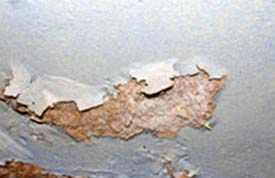
Efflorescence on plaster where salts have blown the paint off the wall
In this situation you need to find the cause and repair it. You can buy Salt Neutraliser treatment (pictured below) and this is covered further in our How To Treat Efflorescence section.
This will prevent salts recurring providing the underlying cause of the problem has been fixed.
It will not pass through paint so you will have to rub down the surface to get back to the bare plaster, render, stone or brick before you start treatment
Efflorescence Treatment – Internal Walls
There is a treatment for efflorescence called Salt Neutraliser which you can buy from most DIY stores. The idea is to stop the remaining salts reacting with water and thereby preventing efflorescence forming.
Salt Neutraliser can be used after the cause of the damp has been eliminated, but this will only be successful if:
- There is no more water passing through the wall.
- It is applied to bare plaster, render, stone or brick. It will not work if used on top of paint or wallpaper.
- If it is efflorescence – other causes of white patches should be investigated and ruled out (see what is efflorescence above).
Other Causes of White Patches
Before you treat for efflorescence you should check out these other causes of white patches:
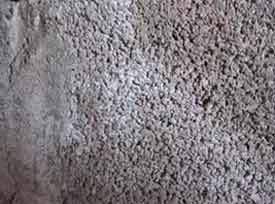
White patches on an internal blockwork wall
An external water leak – before you treat for efflorescence check for the following causes of penetrating damp:
- whether there is a leak from a gutter or downpipe
- if a cistern overflow is running
- if window frame mastic missing
- or a mains pipe is weeping
Penetrating damp – Before you treat the symptoms of efflorescence check for these building defects which may be allowing water to get into the building from outside:
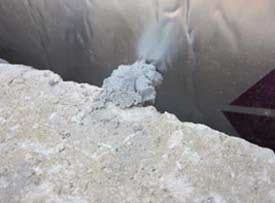
Mortar breaching the cavity in a double skin wall, this could allow water to travel from the external wall to the internal wall
- a blocked wall cavity (see above)
- damaged wall ties
- a high abutting garden wall
- poor pointing
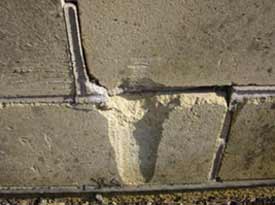
Damaged to walls and pointing can allow damp to penetrate
An internal water leak – before you treat for efflorescence check the following possible internal leaks:
- radiator pipes
- sewerage pipes
- mains water pipes
Free Lime – the result of mortar or concrete curing, or from some clays used in brick making.
Redecorating after Treating Efflorescence
Once your efflorescence issues have been fully cured the next job is to repair any damage that’s been caused by it.
Damaged Wall Plaster – How to Rectify
If the damage to the wall is localised than patching may be possible, however generally the affected areas need to be hacked back to the bare wall. Then you can either:
- Re-plaster to the correct Specification for a damp wall If you are re-plastering it is important you do NOT use modern, lightweight Gypsum-based plasters as you will find the salts will cause damage again
- Use a Membrane lining system which will protect the new surface from the salts in the materials beneath it. You can read more about using a lining system where you have an efflorescence problem in our lining damp walls project here
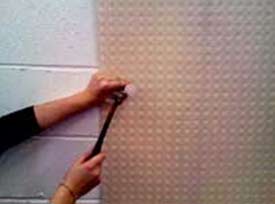
Wall Mesh Membrane can be used to form a barrier between the salts in the wall and the new wall covering
How to Treat Salting on Plaster
- Make sure you have allowed the area to completely dry out (use a dehumidifier if necessary)
- Sand down the area to remove all the salts from the wall, when you are doing this wear a mask to avoid breathing in the dust and wear gloves to protect your skin. You will usually find that the salts will come away easily with medium or fine sandpaper. However in severe cases start with coarse grit sandpaper and down to fine one, to make sure you have a sound surface before you redecorate
- Wipe down the wall with sugar soap (make sure you mix with water to the manufacturer’s specifications) or you can use detergent and water. You can buy specialist efflorescence cleaner if you prefer but this is not necessary if you are using salt neutraliser
- Once it is clean you should rinse down the wall with fresh clean water, to ensure that the wall is free from grease
- Now you are ready to treat the area with a salt neutraliser which is available online from Property Repair Systems (detailed above)
- Once the Salt Neutraliser is fully dry you can redecorate your wall using paint or wallpaper. It is also useful to note that if you are going to paint the area then you may want to use a stain and damp primer before adding your top coat. The stain and damp primer will ensure that no tide marks or marks or any kind will reappear on the surface at any point in the future
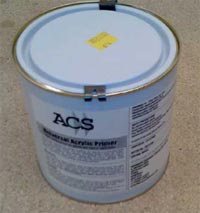
Stain and Damp Seal Paints dry and cure much faster than normal paints which prevents the stain forming through the paint
On the face of it, efflorescence can seem like a fairly major issue, but as long as you fix the actual cause of it and then repair any damaged areas, you shouldn’t get any repeat issues in the future.

